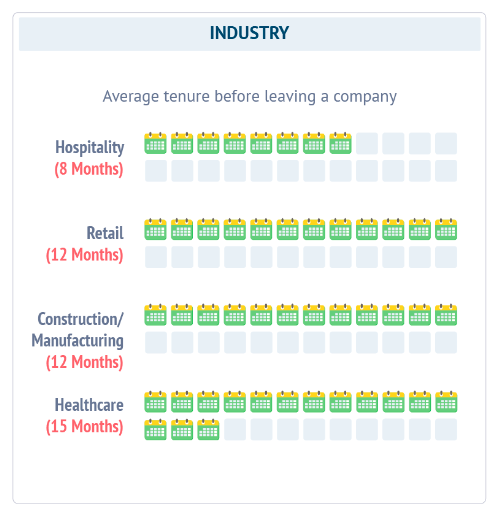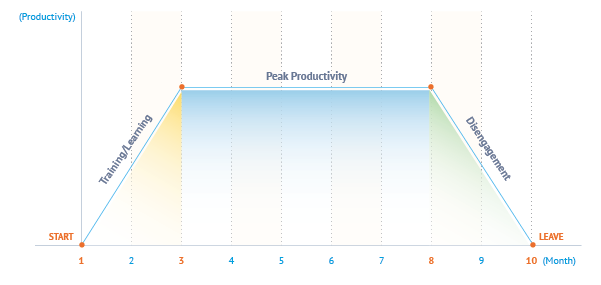Hospitality businesses have retained only half of all new hires made in the last 12 months. Adding to the pressure on businesses, those employees who leave tend to do so after only 8 months service.
Aimed at getting better insight into retention trends for Australian small businesses, Deputy recently released its Employee Retention Report for 2016.
We surveyed over 30,000 employees from nearly 2,000 businesses across the country. As we processed the data a clear picture emerged of the challenges many Australian businesses face with retaining (or losing) staff.
Our examination of Australian workplace trends began with measuring how many new hires were retained by businesses over the last 12 months. We then looked at departing employees to see how long they had worked with a business before leaving:
Unsurprisingly, the hospitality sector ranks lowest in both areas, with half of all new hires for the last 12 months leaving their roles in less than a year. In fact, most staff who leave do it after only 8 months service.
Peak productivity
All employees go through lifecycles with your business, whatever the industry:
- New hires settle into a new role for the first few weeks or months. During this period you’re investing resources in training and development.
- As employees get proficient in their roles they reach “peak productivity” and are able to perform the job to the best of their abilities. As a business owner you want your new hires to reach this stage as quickly and efficiently as possible.
- Employees then need incentives to keep them going or they tend to disengage once they’re used to their role. Familiarity doesn’t necessarily breed contempt, though it can lead to boredom or dissatisfaction.
In businesses with low retention the period of peak productivity is often very short. You invest time and resources to train and develop new hires yet realise only a few months later they’re already disengaged with the role and contemplating leaving.
What this means for your business
Higher overheads
The cost of employee retention is often hidden as it’s hard to put a figure on recruiting and training new hires. Research in the USA has estimated the cost of replacing an $8 USD per hour employee at nearly $10,000. Then there’s the added damage to productivity. If employees at your business turn over every 12 months there’s only a narrow window of time where they’re most engaged and productive.
Customer service threatened
Two symptoms of retention challenges are seen at either end of the loyalty curve when you have higher proportions of staff in the training or disengaged phases of their tenure with you compared to fully productive staff.
This is a problem in particular for the hospitality sector where your workers are the often the face of the business. Quality of service can come under threat from under trained or disengaged staff and you run the risk of losing repeat visits from customers.
Reduced focus on your business
In businesses with low rates of retention managers often spend too much time managing recruitment.
“Every new staff member has to learn new procedures and in turn needs someone to train them in these procedures. This is a costly and time consuming exercise meaning your focus is not 100% on the business but rather on getting people up to speed with the way you do things.”
Phil Gannon – Group Goods And Bev Manager for Sydney Collective
Lower employee morale
If your best workers are constantly having to train new hires they could also become disengaged, spending less time doing meaningful work. Your business may also suffer if top performers can’t do the work they excel at.
Reasons behind poor retention in hospitality
Within the sector younger employees are nearly 3 times harder to retain than older generations. In analysing data from the report we looked into employee retention by generation for different industries:
With its high reliance on younger workers who often fit in shifts between their studies, it’s not so surprising that the hospitality sector experiences high staff turnover. Then add the seasonal nature of many hospitality businesses, who ramp hiring up and down for key periods of the year, and the talent drain looks alarming. It matters most when your competitors deliver a better customer experience than you.
Five things you can do to improve retention
1 Stop using the industry as an excuse
While the hospitality sector is well-known for high turnover and poor retention, other sectors aren’t too far behind or fare even worse. Turnover in the last year for retail is only 8% better. In construction 6 out every 10 new hires Deputy surveyed left their roles in the first 12 months. Accepting high turnover as a norm in your industry means you risk opportunities to grow your business. It stops you from implementing the procedures that can help get retention to a sustainable level for business expansion.
2 Look toward other industries
Most jobs don’t really demand youthful physiques — it’s more about skills and commitment. Look to other industries for inspiration: in the US, some large retail companies seem to actually favour older workers. They view ‘mature workers’ as better employees that can consistently deliver a better customer experience for longer.
“Older people often tend to be more stable and reliable employees. Some retailers, most notably in the U.S., are aggressive hirers of older workers. Walmart is an excellent example. This is a trend that will continue as more people retire from the workforce and then subsequently find they need a part-time job to sustain themselves throughout their retirement.”
Michael Baker, Retail Analyst
Our data shows older employees are nearly three times as loyal as the youngest in the workforce. Read our guide here on evaluating hiring older workers here.
3 Change your mindset
See retention as a key strategic investment for your business and essential to growth. In most hospitality venues your workers are the face of the business and the customer experience they deliver is a key factor in repeat visits.
“We are constantly investing in retention. It is not so much a monetary cost up front but an investment with the customers that turns into dollars. If we have great staff then customers come back.”
Justin Tynan, Group GM, Manly Wharf Hotel
4 Think about reward and recognition
Everyone wants to feel that their work is worthwhile. A variety of tasks and responsibilities will certainly help, though equally important is acknowledgment of a job done well. Highlighting successes helps define the work experience as positive overall, and can motivate employees to keep on performing well.
“Reward and recognition are also key drivers in employee retention with public praise being a very powerful tool in retaining high achievers.”
Phil Gannon, Group Goods And Bev Manager for Sydney Collective
5 Identify and promote talent
Opportunities for greater rewards and development make all the difference for Employees looking to their futures, rather than just turning up day-by-day, want opportunities for greater rewards, development and status. It’s the difference between a job or a career with a business.
“We have also recently undergone talent reviews for all of our Operation staff. Identifying the key talent in our business and making a plan to provide in house training. We are running a Supervisor training internal 2 day course on the lead up to Xmas for all frontline employees we have identified as key talent.”
Rachael Cameron, ANZ Payroll Officer, Magic Memories
Download the report
To download the full Employee Retention Report 2016 enter your email address below:


